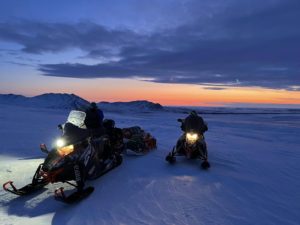Day 34 / Apr 8
The Porcupine gave the Guys a challenge yesterday; deep snow with slush underneath for most the day was hard on fuel, men and machines. The good news is that they were able to rest safely in a cabin last night and believe they are through the “Ramparts” and the trail ahead will be easier going. They’re well on their way today and hopefully they will make it into Fort Yukon this evening.
Fort Yukon is an Alaskan town that straddles the Arctic Circle. This area has been occupied for thousands of years by Gwich’in people, but the village of Fort Yukon developed from a trading post, Fort Yukon, established by … you guessed it… the Hudson’s Bay Company, in June of 1847.
As you can imagine, Fort Yukon has a long, deep history, but I want to focus on the climate. At the confluence of the Yukon and Porcupine rivers, and roughly 150 miles northeast of Fairbanks, Fort Yukon has a strong subarctic climate. In fact, in summer they have midnight sun- meaning the sun nearly never sets, whereas in December the sun only appears for a few hours each day.
Just as the sun seems to go from one extreme to the next, so do the temperatures. Summer temperatures in Fort Yukon are high considering how far North they are and average mid 70s(F). Until just recently, Fort Yukon held the highest temperature ever recorded in Alaska when it reached 100F in 1915. In the winter months, one can expect an average of -10F; Fort Yukon holds the record for the lowest mean monthly temperature when the notoriously cold month of December 1917 had an average daily temperature of −48.3 °F.
This area may bring some big swings in daylight and weather but it’s also one of the best places in the world for observing the Aurora Borealis.
For those who are interested in learning more about the area, you may want to check out the book “Above the Arctic Circle: The Alaska Journals of James A. Carroll 1911-1922” by James A. Carroll. This book shares the journey of a young man of 17 who leaves his home in Minnesota in hopes of Alaskan gold, but stays for the land and the people. The book is a memoir of his first ten years as a trapper in Fort Yukon from 1911-1922 and the many adventures he encountered.

